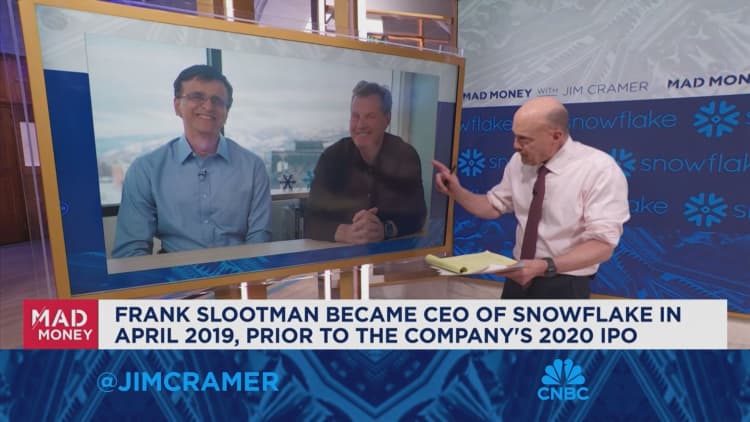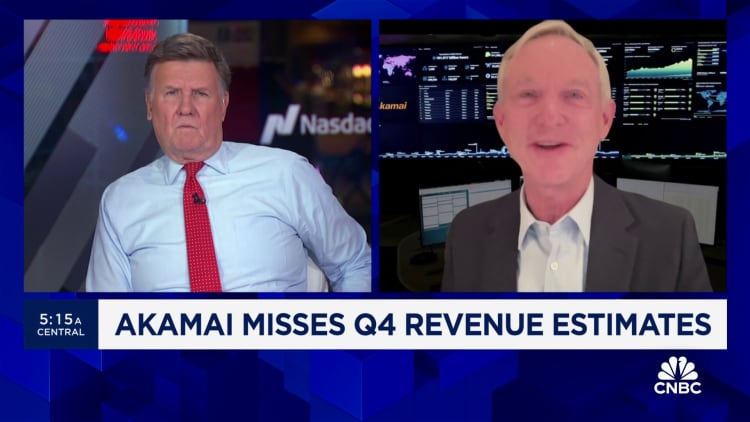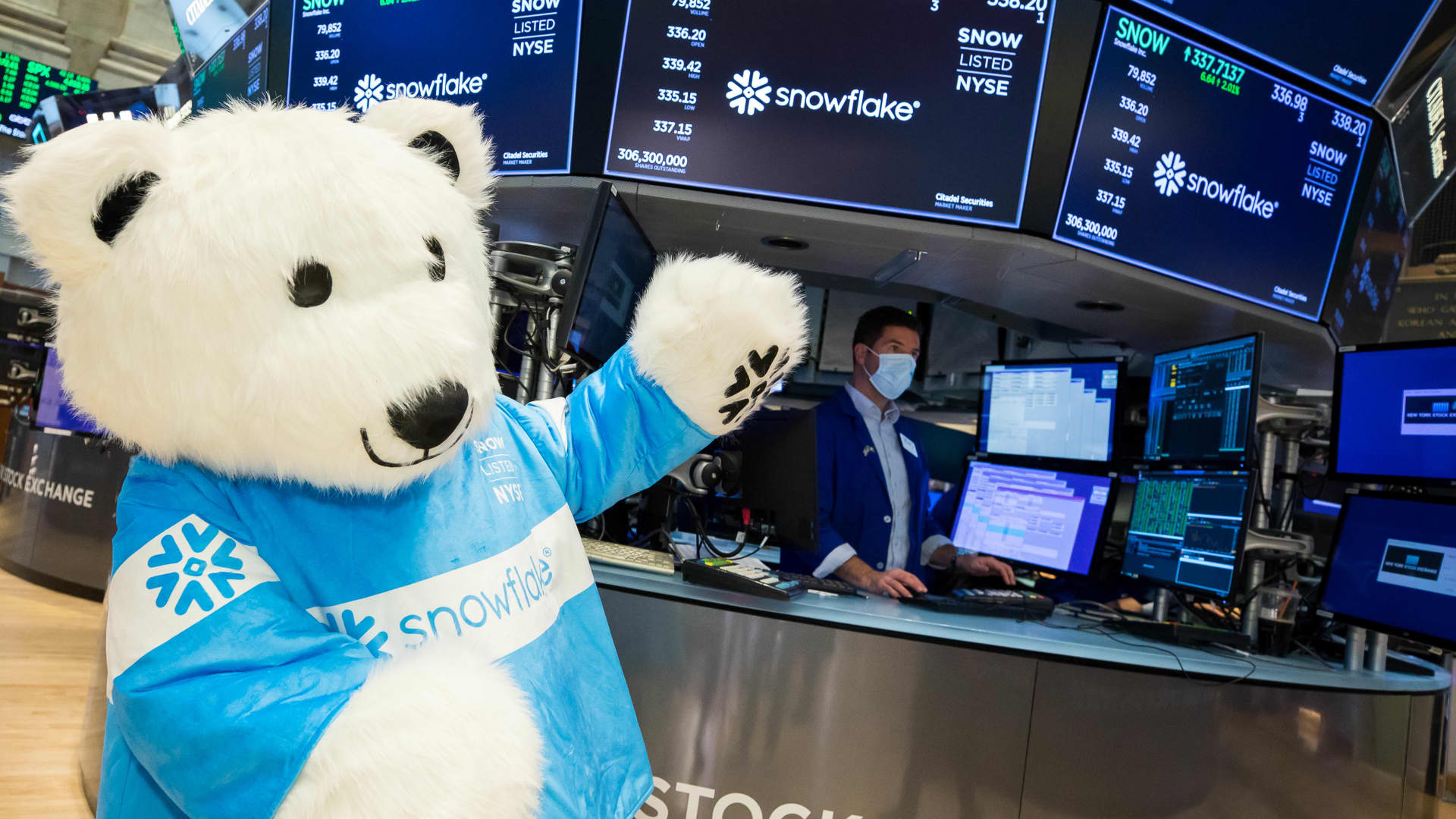The New York Stock Exchange welcomes Snowflake to usher in the first day of winter on Dec. 21, 2021. To honor the occasion, Snowflake the Bear, joined by Chris Taylor, vice president of NYSE Listings and Services, rings the opening bell.
NYSE
In 2020, as data analytics software vendor Snowflake was hitting the public market, one of the key stats it was touting to investors was net revenue retention.
Snowflake’s NRR at the time was 158%, meaning its existing customer base from a year earlier had increased its total spend by 58%. The measurement reflects demand from clients for more products and services and is beloved by Wall Street because it signifies added revenue without much additional cost.
However, in the quarter that ended in January of this year, Snowflake’s NRR dipped to 131%, a number that is still high by industry standards yet indicates a slowdown in new spending. It is a trend that is popping up across the cloud software industry, as former fast-growing businesses contend with a more conservative approach from the companies, governments and other entities they serve, whether the buyers are finance, marketing or IT departments.
“The median net retention for the software universe has been steadily declining the last few quarters,” Jamin Ball, a partner at tech-focused investment firm Altimeter Capital, wrote in a post on social media site X on Friday. “More pressure on churn (as companies look to reduce point solutions in favor of platforms) and more difficult upsells have pushed net retention down,” Ball added.
Industrywide, the median net retention rate declined to 111% in the fourth quarter, as the number ticks down a bit each period, Ball’s data shows. According to the four-year chart he posted, NRR peaked at 121% in the first quarter of 2022, which was just after tech stocks reached a record and had started a precipitous decline.
The retrenchment has continued even with interest rates stabilizing, the economy showing signs of strength and the Nasdaq wiping out all of its losses from 2022 to reach fresh highs.
Twilio, which sells cloud-based communications software, reported NRR of 102% in February, with just 5% year-over-year revenue growth. Rewind to the fourth quarter of 2020 and the company’s NRR was 139%.
Almost all of Twilio’s revenue comes from its division that contains technology for sending text messages and emails.
“We are seeing low churn in that business, but relative to historical levels kind of pre-2023, just higher contraction and more muted expansion,” Aidan Viggiano, Twilio’s finance chief, said on the company’s earnings call in February.
At Snowflake, Chief Financial Officer Mike Scarpelli told investors last month that NRR will at some point converge with its revenue growth rate, which slowed to 36% in the latest fiscal year from 69% in fiscal 2023 and 106% the year before that.
The topic didn’t get much discussion on Snowflake’s earnings call, as analysts were focused on the announcement that Sridhar Ramaswamy was replacing CEO Frank Slootman, the veteran Silicon Valley executive who led Snowflake through its 2020 initial public offering, the largest ever for a U.S. software company.
Representatives from Twilio and Snowflake declined to comment.

The story is similar at Zoom, which has seen its enterprise net retention rate slip to 101% from more than 130% three years ago.
Zoom has opted to add artificial intelligence features into its premium video-calling plans at no additional cost. That is different than the approach taken by competitors Google and Microsoft, which are generally forcing companies to pay for new AI capabilities.
“Because customers are also trying to reduce the cost, that’s why we do not charge the customers for those features,” Zoom CEO Eric Yuan said on his company’s earnings call last month.
Zoom did not respond to CNBC’s request for comment.
Even Amazon CEO Andy Jassy said “cost optimization” is having an effect on business. Amazon Web Services doesn’t break out NRR, but the division reported annual revenue growth in the fourth quarter of 13%, down from 20% a year earlier. Jassy said he sees the market starting to show signs of a reacceleration.
“I think that the lion’s share of cost optimization has happened,” Jassy said. “It’s not that there won’t be any more or that we don’t see any more. But it’s just attenuated very significantly.”
An AWS spokesperson told CNBC in a statement that “customers are renewing at larger commitments over longer periods.”
‘Additional down-sell pressure’
ZoomInfo, which sells access to data that companies can use to help drive sales, reported a dramatic drop in NRR to 87% at the end of 2023 from 116% two years earlier. That means existing customers are spending less year over year.
Midsize companies, especially in technology, were the customers feeling the most heat in the fourth quarter, ZoomInfo CFO Cameron Hyzer told analysts on last month’s earnings call. ZoomInfo ended the fourth quarter with 1,820 customers holding at least $100,000 in annual contract value on Dec. 31, down from 1,869 clients at that level on Sept. 30.
“We anticipate additional down-sell pressure in Q1 as we are still lapping a peak of negativity from last year and working through the long tail of multiannual contracts that were most recently transacted in a very different operating environment,” Hyzer said. Management expects the retention rate to return to higher levels this year, he said.
DigitalOcean, which competes with AWS, Microsoft and Google in providing cloud computing and storage services, also saw NRR dip below 100% last year. After hitting 112% in the fourth quarter of 2022, the rate dropped to 107% to start 2023 and then fell to 96% in the third and fourth quarters.
Paddy Srinivasan, who was named CEO of DigitalOcean in January, told CNBC in an interview in February that developers are turning off computing instances that they are not currently using.
Like at AWS, Srinivasan said DigitalOcean is “starting to see stabilization.”
Representatives from ZoomInfo and DigitalOcean did not respond to CNBC’s requests for comment.








